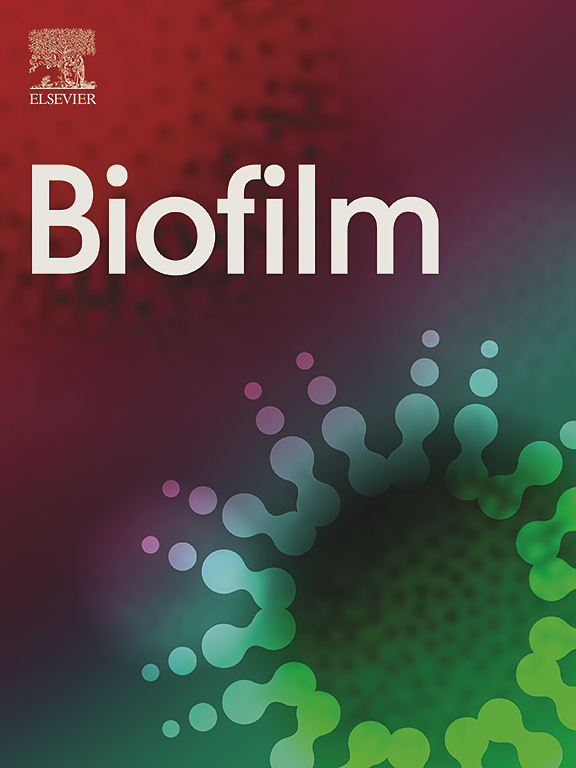Decoding interactions between biofilms and DNA nanoparticles
IF 4.9
Q1 MICROBIOLOGY
引用次数: 0
Abstract
Biofilms present a great challenge in antimicrobial therapy due to their inherent tolerance to conventional antibiotics, promoting the need for advanced drug delivery strategies that improve therapy. While various nanoparticles (NPs) have been reported for this purpose, DNA-based NPs remain a largely unexploited resource against biofilm-associated infections. To fill this gap and to lay the groundwork for their potential therapeutic exploitation, we investigated the diffusion, penetration, and retention behaviors of three DNA-based nanocarriers —plain or modified—within P. aeruginosa biofilms. Watson-Crick base pairing or hydrophobic interactions mediated the formation of the plain NPs whilst electrostatic interaction enabled optimization of coated NPs via microfluidic mixing. We assessed the interactions of the nanocarriers with biofilm structures via Single Plane Illumination Microscopy – Fluorescence Correlation Spectroscopy (SPIM-FCS) and Confocal Laser Scanning Microscopy (CLSM). We demonstrate the impact of microfluidic parameters on the physicochemical properties of the modified DNA NPs and their subsequent distinct behaviors in the biofilm. Our results show that single stranded DNA micelles (ssDNA micelle) and tetrahedral DNA nanostructures (TDN) had similar diffusion and penetration profiles, whereas chitosan-coated TDN (TDN-Chit) showed reduced diffusion and increased biofilm retention. This is attributable to the relatively larger size and positive surface charge of the TDN-Chit NPs. The study shows first and foremost that DNA can be used as building block in drug delivery for antibiofilm therapeutics. Moreover, the overall behavioral findings are pivotal for the strategic selection of therapeutic agents to be encapsulated within these structures, possibly affecting the treatment efficacy. This research not only highlights the underexplored potential of DNA-based NPs in antibiofilm therapy but also advocates for further studies using different optimization strategies to refine these nanocarrier systems for targeted treatments in biofilm-related infections.

解码生物膜和DNA纳米颗粒之间的相互作用
由于生物膜对传统抗生素的固有耐受性,生物膜在抗菌治疗中提出了巨大的挑战,促进了对先进药物递送策略的需求,以改善治疗。虽然各种纳米颗粒(NPs)已被报道用于此目的,但基于dna的NPs仍然是一种很大程度上未开发的对抗生物膜相关感染的资源。为了填补这一空白并为其潜在的治疗开发奠定基础,我们研究了三种基于dna的纳米载体(普通的或修饰的)在铜绿假单胞菌生物膜中的扩散、渗透和保留行为。沃森-克里克碱基配对或疏水相互作用介导了平面NPs的形成,而静电相互作用通过微流体混合实现了涂覆NPs的优化。我们通过单平面照明显微镜-荧光相关光谱(SPIM-FCS)和共聚焦激光扫描显微镜(CLSM)评估了纳米载体与生物膜结构的相互作用。我们展示了微流控参数对修饰DNA NPs的物理化学性质及其随后在生物膜中的不同行为的影响。我们的研究结果表明,单链DNA胶束(ssDNA胶束)和四面体DNA纳米结构(TDN)具有相似的扩散和渗透特征,而壳聚糖包覆的TDN (TDN- chit)则表现出扩散减少和生物膜保留增加的特征。这是由于TDN-Chit NPs的尺寸和表面正电荷相对较大。这项研究首先表明,DNA可以作为抗生素生物膜疗法药物输送的基石。此外,整体行为学研究结果对战略性选择治疗药物至关重要,这些药物被封装在这些结构中,可能会影响治疗效果。本研究不仅强调了基于dna的NPs在抗生物膜治疗中的潜力,而且提倡进一步研究使用不同的优化策略来完善这些纳米载体系统,以靶向治疗生物膜相关感染。
本文章由计算机程序翻译,如有差异,请以英文原文为准。
求助全文
约1分钟内获得全文
求助全文

 求助内容:
求助内容: 应助结果提醒方式:
应助结果提醒方式:


